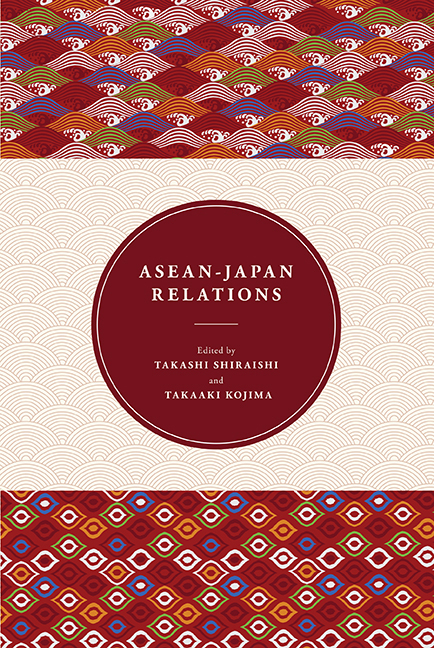Book contents
- Frontmatter
- Contents
- Preface
- About the Contributors
- 1 An Overview of Japan-ASEAN Relations
- 2 Japan's Relations with ASEAN
- 3 Approaches toward Regionalism: Japan, China and the Implications on ASEAN
- 4 The New Japan-ASEAN Partnership: Challenges in the Transformation of the Regional Context in East Asia
- 5 ASEAN-Japan Strategic Partnership and Regional Integration: Impacts and Implications
- 6 ASEAN-Japan Cooperation on Maritime Non-Traditional Security Issues: Toward a New Paradigm
- 7 Japan's Evolving Security Concerns in Maritime Southeast Asia: From Safety of Navigation to “Lake Beijing”
- 8 Evolution of Institutions and Policies for Economic Integration in East Asia: The Rise of China and Changes in the Regional Order
- 9 Managing Integration in East Asia: Behind Border Issues in Japan-ASEAN Trade Agreements
- 10 Regional Financial Cooperation in East Asia: Development and Challenges
- 11 Japanese Development Assistance to ASEAN Countries
- 12 Japanese Foreign Direct Investment in the ASEAN-4 Countries
- 13 Japan's Triple Tsunami
- 14 ASEAN-Japan Relations: A Singapore Perspective
8 - Evolution of Institutions and Policies for Economic Integration in East Asia: The Rise of China and Changes in the Regional Order
Published online by Cambridge University Press: 21 October 2015
- Frontmatter
- Contents
- Preface
- About the Contributors
- 1 An Overview of Japan-ASEAN Relations
- 2 Japan's Relations with ASEAN
- 3 Approaches toward Regionalism: Japan, China and the Implications on ASEAN
- 4 The New Japan-ASEAN Partnership: Challenges in the Transformation of the Regional Context in East Asia
- 5 ASEAN-Japan Strategic Partnership and Regional Integration: Impacts and Implications
- 6 ASEAN-Japan Cooperation on Maritime Non-Traditional Security Issues: Toward a New Paradigm
- 7 Japan's Evolving Security Concerns in Maritime Southeast Asia: From Safety of Navigation to “Lake Beijing”
- 8 Evolution of Institutions and Policies for Economic Integration in East Asia: The Rise of China and Changes in the Regional Order
- 9 Managing Integration in East Asia: Behind Border Issues in Japan-ASEAN Trade Agreements
- 10 Regional Financial Cooperation in East Asia: Development and Challenges
- 11 Japanese Development Assistance to ASEAN Countries
- 12 Japanese Foreign Direct Investment in the ASEAN-4 Countries
- 13 Japan's Triple Tsunami
- 14 ASEAN-Japan Relations: A Singapore Perspective
Summary
The signing of the Plaza Accord on currency alignment in the mid-1980s marked the beginning of substantial progress toward genuine economic integration in East Asia in the decade that followed. Multinational companies became established in the region and new business clusters were formed. Progress was also made in terms of systems and policy: efforts were made to liberalize trade and put in place a set of rules that would encourage regional economic integration. A number of Free Trade Agreements (FTA) and Economic Partnership Agreements (EPA) have been signed, and we can be optimistic that economic integration on the systems front will continue in the years to come.
This chapter discusses the game-changing effects of China's increased involvement in the East Asian economic integration process since it joined the World Trade Organization (WTO). We look at how the Association of Southeast Asian Nations (ASEAN) and Japan have responded to date, and consider how they ought to respond in the future.
WTO MEMBERSHIP PROMPTS GREATER CHINESE INVOLVEMENT
How and when did China become fully integrated into the East Asian regional economy, involved diplomatically not just in bilateral but also multilateral efforts? For many years, Japan and ASEAN were the main drivers of de facto economic integration in East Asia. This began to change after China joined the WTO in 2001. China opened FTA negotiations with ASEAN soon after, and became much more directly involved in the regional economic integration process, calling for preliminary studies on an FTA involving ASEAN+3 (Japan, China, and South Korea).
Until the Asian currency crisis of the late 1990s, the main hubs for regionalization in East Asia were Japan and ASEAN. After World War II, the countries that would later form ASEAN passed tough laws regulating foreign investment and attempted to achieve import substitution through steep tariffs. When this approach reached a dead end, the ASEAN countries shifted to an export-driven model of industrialization. It was around this time, with the value of the yen soaring following the Plaza Accord in 1985, that Japanese companies, particularly in the electronics sector, began to make serious investments in ASEAN in order to maintain their international competitiveness.
- Type
- Chapter
- Information
- ASEAN-Japan Relations , pp. 135 - 159Publisher: ISEAS–Yusof Ishak InstitutePrint publication year: 2013

